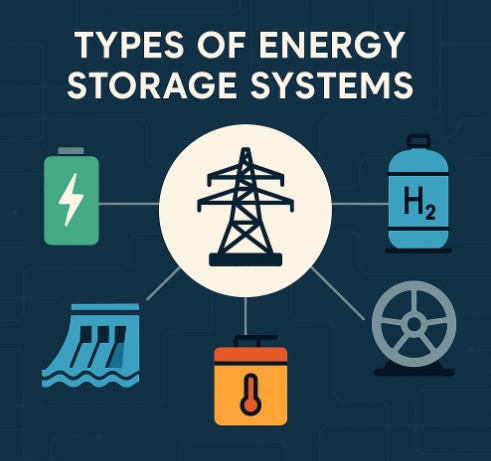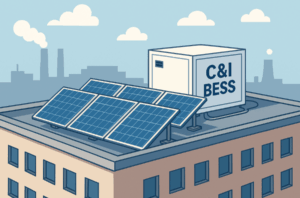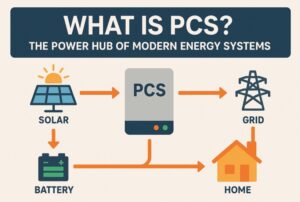- You have no items in your shopping cart
- Subtotal: $0.00

🌍 What Are Energy Storage Systems (ESS)?
Energy Storage Systems (ESS) are technologies that store energy for later use, ensuring a stable, efficient, and reliable power supply. As renewable energy sources like solar and wind grow, ESS is essential to balance fluctuations, reduce waste, and increase grid resilience.
Energy can be stored in different forms—chemical, thermal, mechanical, or electrochemical. Choosing the right ESS depends on the application: grid stability, backup power, renewable integration, or load shifting.
Let’s explore the most common types of energy storage systems, their working principles, use cases, advantages, and limitations.
⚡ 1. Electrochemical Energy Storage (Batteries)
🔋 a. Lithium-Ion Batteries
- How it Works: Stores energy through chemical reactions involving lithium ions moving between anode and cathode.
- Applications: EVs, grid-level BESS, mobile devices, home storage (like Tesla Powerwall).
- Pros: High energy density, fast response, long cycle life.
- Cons: High cost, fire risk, sensitive to temperature.
🔋 b. Lead-Acid Batteries
- How it Works: Uses lead dioxide and sponge lead in sulfuric acid to store/release electricity.
- Applications: UPS systems, automotive, small-scale backup power.
- Pros: Low cost, mature technology.
- Cons: Shorter life span, heavy, poor energy density.
🔋 c. Sodium-Sulfur (NaS) Batteries
- How it Works: Uses molten sulfur and sodium at high temperatures to generate electricity.
- Applications: Grid-scale storage in Japan and the US.
- Pros: High energy density, long cycle life.
- Cons: Operates at ~300°C, safety concerns.
🔋 d. Flow Batteries (e.g., Vanadium Redox)
- How it Works: Stores energy in external tanks of liquid electrolytes; electricity is generated via ion exchange across a membrane.
- Applications: Utility-scale energy storage.
- Pros: Long cycle life, decoupled power & energy capacity.
- Cons: Low energy density, complex system.
🌡️ 2. Thermal Energy Storage
Thermal ESS stores energy as heat or cold to be used later for electricity or HVAC.
🔥 a. Sensible Heat Storage (e.g., Molten Salt)
- How it Works: Stores heat in materials like molten salt or rocks.
- Applications: Concentrated solar power (CSP) plants.
- Pros: Cost-effective, scalable.
- Cons: Limited to thermal applications, heat losses over time.
❄️ b. Latent Heat Storage (Phase Change Materials)
- How it Works: Stores energy by changing phase (solid <-> liquid).
- Applications: Building heating/cooling systems.
- Pros: High energy density.
- Cons: Limited temperature range, material degradation.
⚙️ 3. Mechanical Energy Storage
⛰️ a. Pumped Hydro Storage (PHS)
- How it Works: Pumps water to a higher reservoir and releases it through turbines to generate electricity.
- Applications: Grid-level energy shifting.
- Pros: Long lifespan (50+ years), low O&M cost.
- Cons: Location-dependent, long construction time.
🌀 b. Flywheel Energy Storage
- How it Works: Stores energy in a rotating mass and releases it by slowing the wheel.
- Applications: Frequency regulation, UPS.
- Pros: Very fast response, long cycle life.
- Cons: Self-discharge, limited energy capacity.
🏔️ c. Compressed Air Energy Storage (CAES)
- How it Works: Stores air under pressure in underground caverns; air is released to power turbines.
- Applications: Grid-scale storage.
- Pros: Large-scale potential.
- Cons: Efficiency limited (~50%), requires suitable geology.
🧪 4. Chemical Energy Storage
💧 Hydrogen Storage (Green Hydrogen)
- How it Works: Electricity (usually from renewables) is used to electrolyze water into hydrogen, which is stored and later used in fuel cells or burned for power.
- Applications: Long-duration energy storage, mobility, industrial heating.
- Pros: High energy density, zero carbon emissions if green.
- Cons: Low round-trip efficiency, expensive infrastructure, safety concerns.
Hydrogen ESS Types:
- Compressed Gas Hydrogen
- Liquid Hydrogen
- Solid Hydrogen (metal hydrides)
🧱 5. Gravitational Energy Storage
- How it Works: Lifts heavy weights using electricity and drops them to generate electricity via a generator.
- Examples: Energy Vault.
- Pros: Long life, low degradation.
- Cons: Limited commercial deployment, low energy density.
🏭 6. Supercapacitors & Ultracapacitors
- How it Works: Stores energy electrostatically, not chemically.
- Applications: Short-term storage, quick charge/discharge needs (e.g., regenerative braking).
- Pros: Very fast response, long life.
- Cons: Low energy density, can’t store large amounts.
🧯 7. Hybrid Energy Storage Systems
- What It Is: Combination of two or more storage systems to leverage individual strengths.
- Example: Battery + Supercapacitor for EVs.
- Benefits: Better efficiency, flexibility, and optimized performance.
🧩 Comparison Table of ESS Types
| Type | Energy Density | Response Time | Cycle Life | Use Case |
|---|---|---|---|---|
| Lithium-ion Battery | High | Seconds | High | EVs, BESS, Consumer |
| Flow Battery | Medium | Seconds | Very High | Grid Storage |
| PHS | Medium | Minutes | Very High | Grid Balancing |
| CAES | Low-Medium | Minutes | High | Grid Backup |
| Thermal Storage | Low-Medium | Minutes-Hours | High | Solar Plants, HVAC |
| Hydrogen Storage | High (mass) | Slow | Medium | Long-duration storage |
| Flywheel | Low | Milliseconds | Very High | Frequency Regulation |
| Supercapacitor | Very Low | Milliseconds | Very High | Quick Bursts |
❓ FAQs
Q1: Which ESS is best for renewable energy storage?
Lithium-ion and flow batteries are top choices due to high efficiency and scalability. For long-term storage, hydrogen is emerging as a strong option.
Q2: What is the most efficient energy storage system?
Supercapacitors are highly efficient (~95%) for short bursts. Lithium-ion also ranks high for overall grid and commercial uses.
Q3: Can energy be stored without batteries?
Yes. Pumped hydro, hydrogen, flywheels, and thermal systems store energy without using chemical batteries.
🧠 Final Thoughts
As we move toward a decarbonized and electrified future, energy storage systems are no longer optional—they are foundational. From small homes to massive grid infrastructures, the right storage technology ensures efficiency, sustainability, and reliability.
Each ESS has its own strengths and weaknesses. There’s no “one-size-fits-all.” The smartest approach? Choose based on energy needs, duration, budget, and space.
Stay informed, choose wisely, and build a more resilient energy future.


